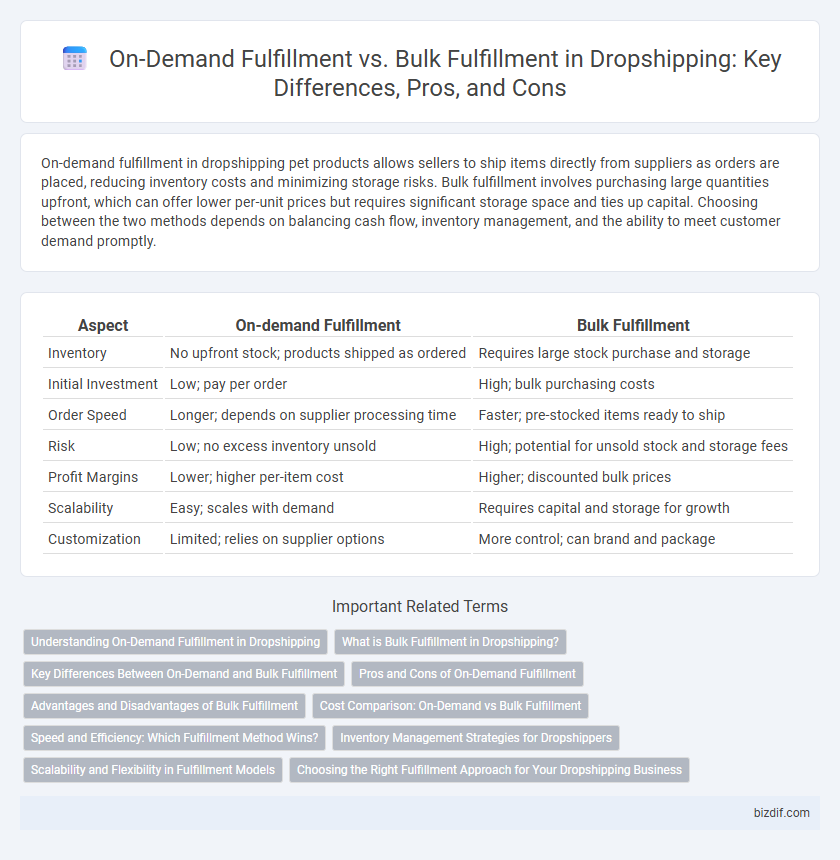On-demand fulfillment in dropshipping pet products allows sellers to ship items directly from suppliers as orders are placed, reducing inventory costs and minimizing storage risks. Bulk fulfillment involves purchasing large quantities upfront, which can offer lower per-unit prices but requires significant storage space and ties up capital. Choosing between the two methods depends on balancing cash flow, inventory management, and the ability to meet customer demand promptly.
Table of Comparison
| Aspect | On-demand Fulfillment | Bulk Fulfillment |
|---|---|---|
| Inventory | No upfront stock; products shipped as ordered | Requires large stock purchase and storage |
| Initial Investment | Low; pay per order | High; bulk purchasing costs |
| Order Speed | Longer; depends on supplier processing time | Faster; pre-stocked items ready to ship |
| Risk | Low; no excess inventory unsold | High; potential for unsold stock and storage fees |
| Profit Margins | Lower; higher per-item cost | Higher; discounted bulk prices |
| Scalability | Easy; scales with demand | Requires capital and storage for growth |
| Customization | Limited; relies on supplier options | More control; can brand and package |
Understanding On-Demand Fulfillment in Dropshipping
On-demand fulfillment in dropshipping involves processing and shipping products only after a customer places an order, eliminating the need for inventory storage and reducing upfront costs. This model allows for greater product variety and flexibility, as sellers can offer a wide range of items without the risk of unsold stock. Delivery times may be longer compared to bulk fulfillment, but it optimizes cash flow and minimizes financial risk for dropshipping businesses.
What is Bulk Fulfillment in Dropshipping?
Bulk fulfillment in dropshipping refers to processing and shipping large orders simultaneously rather than individually. This method allows sellers to purchase inventory in bulk from suppliers, store it, and then fulfill customer orders efficiently, reducing per-unit shipping costs and improving delivery speed. Bulk fulfillment is ideal for businesses with consistent demand, enabling better inventory control and profit margins.
Key Differences Between On-Demand and Bulk Fulfillment
On-demand fulfillment processes orders individually as they are received, minimizing inventory costs and reducing the risk of overstock, whereas bulk fulfillment involves purchasing and storing large quantities of products upfront to meet anticipated demand. On-demand fulfillment allows for greater product variety and flexibility, while bulk fulfillment typically offers lower per-unit costs due to volume purchasing. Inventory management and cash flow impact differ significantly, with on-demand relying on suppliers' timely shipping, and bulk requiring efficient warehouse operations.
Pros and Cons of On-Demand Fulfillment
On-demand fulfillment offers flexibility by allowing sellers to process orders as they come, reducing upfront inventory costs and minimizing storage needs. This model enables quick adaptation to market trends and custom product offerings but may lead to longer shipping times and higher per-unit costs compared to bulk fulfillment. While on-demand fulfillment reduces financial risk and overstock issues, it can challenge scalability due to dependency on third-party suppliers and variable production schedules.
Advantages and Disadvantages of Bulk Fulfillment
Bulk fulfillment offers cost efficiency by purchasing large quantities at discounted rates, reducing per-unit costs and boosting profit margins. However, it requires significant upfront investment and storage space, increasing the risk of unsold inventory and cash flow challenges. Managing bulk stock also demands robust inventory control systems to prevent overstocking and ensure timely order fulfillment in dropshipping operations.
Cost Comparison: On-Demand vs Bulk Fulfillment
On-demand fulfillment minimizes upfront inventory costs by processing orders individually, reducing storage expenses but often incurring higher per-unit shipping fees. Bulk fulfillment requires substantial initial investment in inventory and warehousing, benefiting from economies of scale that lower overall cost per unit and shipping expenses. Efficient cost management in dropshipping depends on balancing the cash flow benefits of on-demand fulfillment against the per-unit savings achieved through bulk purchasing.
Speed and Efficiency: Which Fulfillment Method Wins?
On-demand fulfillment excels in speed and efficiency by processing orders individually, reducing inventory costs, and enabling faster shipping directly from suppliers. Bulk fulfillment, however, offers cost advantages through large-volume shipments and streamlined warehouse operations but may involve longer handling times and storage logistics. For businesses prioritizing rapid delivery and flexibility, on-demand fulfillment often outperforms bulk methods in overall efficiency and customer satisfaction.
Inventory Management Strategies for Dropshippers
On-demand fulfillment allows dropshippers to minimize inventory holding costs by shipping products directly from suppliers only after a customer places an order, reducing risks of overstocking and obsolete inventory. Bulk fulfillment requires purchasing and storing large quantities upfront, enabling faster shipping times and potentially lower per-unit costs but increasing warehousing expenses and inventory management complexity. Effective dropshipping inventory management balances demand forecasting accuracy, supplier reliability, and cash flow considerations to optimize order processing and minimize stockouts or excess stock.
Scalability and Flexibility in Fulfillment Models
On-demand fulfillment offers maximum flexibility by processing orders individually, allowing dropshipping businesses to scale without the need for large inventory investments. Bulk fulfillment provides scalability through pre-purchasing stock in larger quantities, reducing per-unit costs but requiring upfront capital and increased storage management. Choosing between these models involves balancing rapid adaptability with cost efficiency in inventory handling.
Choosing the Right Fulfillment Approach for Your Dropshipping Business
Selecting the right fulfillment approach directly impacts your dropshipping business's efficiency and customer satisfaction. On-demand fulfillment minimizes inventory costs and suits a wide product range with unpredictable demand, while bulk fulfillment enables faster shipping times and lower per-unit costs through inventory storage. Evaluating factors such as order volume, cash flow, and product turnover helps determine whether on-demand or bulk fulfillment best aligns with your operational goals and market strategy.
On-demand Fulfillment vs Bulk Fulfillment Infographic

 bizdif.com
bizdif.com